A Coupling Coordination Assessment of the Land–Water–Food Nexus in China
Abstract
:1. Introduction
2. Data and Methodology
2.1. Study Area
2.2. Research Design
2.3. Research Methods
2.3.1. Construction of Comprehensive Evaluation Index for LWF Nexus
2.3.2. Combined Weighting Method
- (1)
- Standardization of data:where t is the year, i is the region, j is the indicator, rtij is the standardized result of the indicator, xtij is the value of indicator j for region i in year t, and max (xj) and min (xj) are, respectively, the maximum and minimum values of indicator j.
- (2)
- Normalization of indicators:where θ is the total number of years, m is the total number of regions, and ptij is the weight of indicator j for region i in year t. If ptij = 0, then ptijln(ptij) is defined as 0.
- (3)
- Calculating the information entropy:where ej is the information entropy of indicator j, satisfying 0 ≤ ej ≤ 1.
- (4)
- Calculating the redundancy:where dj is the redundancy of indicator j.
- (5)
- Calculating the entropy method weight:where wj’ is the entropy method weight of indicator j and n is the total number of indicators.
- (6)
- Calculating the coefficient of variation method weight:where wj″ is the coefficient of variation method weight of indicator j, vj is the coefficient of variation in indicator j, σj is the standard deviation of indicator j, and is the average value of indicator j.
- (7)
- Combined weighting:where wj is the combined weight of indicator j. The weight values of various indicators determined using the above method are shown in Table 1.
2.3.3. Integrated Evaluation Model
2.3.4. Coupling Coordination Degree Model
2.3.5. Exploring Spatial Data Analysis
2.3.6. Spatial Tobit Model
2.3.7. GM (1, 1) Model
2.4. Data Sources
3. Results
3.1. Analysis of the Development Level of the LWF Nexus
3.1.1. Measurement of Comprehensive Development Index of LWF Nexus
3.1.2. Evolution of Comprehensive Development Index of China’s LWF Nexus
3.2. Coupling Coordinated Degree Development of the LWF Nexus
3.2.1. Measurement of Coupling Coordinated Development of the LWF Nexus
3.2.2. Characteristics of Coupling Coordinated Development of LWF Nexus in China
3.3. Spatial Correlations of Coupling Coordination Degree
3.4. Influencing Factors on Coupling Coordination Degree in China
3.5. Future Trend of Coupling Coordination Degree
4. Discussion
5. Conclusions and Suggestions
5.1. Conclusions
- (1)
- The comprehensive development index of land in 31 provinces (municipal cities, autonomous regions) ranges from 0.162 to 0.497, the comprehensive development index of water ranges from 0.164 to 0.729, and the comprehensive development index of food ranges from 0.284 to 0.741. During the research period, the comprehensive development level of the land system lagged behind the water system and the food system. The comprehensive development level of China’s LWF nexus shows an upward trend. In regions with relatively abundant land resources, water resources, and food production resources, the level of the LWF nexus is relatively high, while in regions with relatively weak water and land resources, the level of the LWF nexus is relatively low.
- (2)
- The coupling coordination level of the LWF nexus in different regions ranges from 0.538 to 0.754, involving the barely coupled coordination type, preliminary coupled coordination type, and intermediate coupled coordination type. Among them, the average annual change rate of coupling coordination degree in Beijing is the highest, at 1.26%, and that in Xinjiang is the lowest, at 0.28%. The coupling coordination development of China’s LWF nexus has reached the preliminary coupled coordination type, and its evolution is similar to the evolution of the comprehensive development level. Through the orderly promotion of the comprehensive development level of resource utilization and food production, the coupling coordination development of the LWF nexus can be effectively achieved.
- (3)
- There is a significant spatial positive correlation between coupling coordination development levels for the LWF nexus in China, and it shows an increasing trend over time. The High–High Clusters are mainly concentrated in the eastern coastal regions, while the Low–Low Clusters occupy more provinces, mainly in the central and western regions. The spatial Tobit regression results show that urbanization level and agricultural industry agglomeration have a negative impact on the coupling coordination development of China’s LWF nexus, while economic development, ecological environment, and scientific and technological progress all have a positive impact.
- (4)
- The coupling coordination development of the LWF nexus in China shows a steady upward trend from 2024 to 2025, basically continuing the trend of changes from 2005 to 2020. If the current state is maintained, the LWF nexus in most regions will reach the intermediate coupled coordination type by 2025, while the development of the LWF nexus in western regions still needs to be strengthened.
5.2. Policy Suggestions
Author Contributions
Funding
Institutional Review Board Statement
Data Availability Statement
Conflicts of Interest
References
- UN. Agenda 21. United Nations Conference on Environment & Development; United Nations: New York, NY, USA, 1992. [Google Scholar]
- UN. The Millennium Development Goals Report 2015; United Nations: New York, NY, USA, 2015. [Google Scholar]
- UN. Transforming Our World: The 2030 Agenda for Sustainable Development; United Nations: New York, NY, USA, 2015. [Google Scholar]
- UN. The Sustainable Development Goals Report 2020; United Nations: New York, NY, USA, 2020. [Google Scholar]
- Jeffrey, D.S.; Guillaume, L.; Christian, K.; Grayson, F.; Finn, W. Sustainable Development Report 2022: From Crisis to Sustainable Development: The SDGs as Roadmap to 2030 and Beyond; Cambridge University Press: Cambridge, UK, 2022. [Google Scholar]
- Xin, M.; Guo, H.; Li, S.; Chen, L. Can China achieve ecological sustainability? An LMDI analysis of ecological footprint and economic development decoupling. Ecol. Indic. 2023, 151, 110303. [Google Scholar] [CrossRef]
- Song, M.; Tao, W.; Shang, Y.; Zhao, X. Spatiotemporal characteristics and influencing factors of China’s urban water resource utilization efficiency from the perspective of sustainable development. J. Clean. Prod. 2022, 338, 130649. [Google Scholar] [CrossRef]
- Song, J.; Liu, C.; Xing, J.; Yang, W.; Ren, J. Linking bioenergy production by agricultural residues to sustainable development goals: Prospects by 2030 in China. Energy Convers. Manag. 2023, 276, 116568. [Google Scholar] [CrossRef]
- Bai, X.; Wang, K.; Tran, T.; Sadip, M.; Trung, L.M.; Khudoykulov, K. Measuring China’s green economic recovery and energy environment sustainability: Econometric analysis of sustainable development goals. Econ. Anal. Policy 2022, 75, 768–779. [Google Scholar] [CrossRef]
- Wang, Z.; Fu, H.; Liu, H.; Liao, C. Urban development sustainability, industrial structure adjustment, and land use efficiency in China. Sustain. Cities Soc. 2023, 89, 104338. [Google Scholar] [CrossRef]
- Feng, T.; Xiong, R.; Huan, P. Productive use of natural resources in agriculture: The main policy lessons. Resour. Policy 2023, 85, 103793. [Google Scholar] [CrossRef]
- Fitton, N.; Alexander, P.; Arnell, N.; Bajzelj, B.; Calvin, K.; Doelman, J.; Gerber, S.; Havlik, P.; Hasegawa, T.; Herrero, M.; et al. The vulnerabilities of agricultural land and food production to future water scarcity. Glob. Environ. Change 2019, 58, 101944. [Google Scholar] [CrossRef]
- He, G.; Zhao, Y.; Wang, L.; Jiang, S.; Zhu, Y. China’s food security challenge: Effects of food habit changes on requirements for arable land and water. J. Clean. Prod. 2019, 229, 739–750. [Google Scholar] [CrossRef]
- Li, C.; Zhou, X.; Zhou, Y. The Characteristics and Influencing Factors of Coupling Coordination Between Water-soil Matching Coefficient and Grain Production in the Lower Reaches of the Yellow River. Econ. Geogr. 2022, 42, 177–185. [Google Scholar]
- Wang, X.; Xin, L.; Tan, M.; Li, X.; Wang, J. Impact of spatiotemporal change of cultivated land on food-water relations in China during 1990–2015. Sci. Total Environ. 2020, 716, 137119. [Google Scholar] [PubMed]
- Zhou, Y.; Zhong, Z.; Cheng, G. Cultivated land loss and construction land expansion in China: Evidence from national land surveys in 1996, 2009 and 2019. Land Use Policy 2023, 125, 106496. [Google Scholar] [CrossRef]
- Xia, J.; Su, R.; He, X.; Huang, Y. Water resources problems in China and their countermeasures and suggestions. Bull. Chin. Acad. Sci. 2008, 2, 116–120. (In Chinese) [Google Scholar]
- Li, F.; Ma, S.; Liu, X. Changing multi-scale spatiotemporal patterns in food security risk in China. J. Clean. Prod. 2023, 384, 135618. [Google Scholar]
- Ibarrola-Rivas, M.; Granados-Ramírez, R.; Nonhebel, S. Is the available cropland and water enough for food demand? A global perspective of the Land-Water-Food nexus. Adv. Water Resour. 2017, 110, 476–483. [Google Scholar] [CrossRef]
- Huang, X.; Fang, H.; Wu, M.; Cao, X. Assessment of the regional agricultural water-land Nexus in China: A green-blue water perspective. Sci. Total Environ. 2022, 804, 150192. [Google Scholar] [CrossRef] [PubMed]
- Mu, Y. Research on the path and mechanism toward effective utilization of water resources to ensure food security. Theory. J. 2022, 6, 110–118. (In Chinese) [Google Scholar]
- Zheng, Y.; Hong, J.; Qin, W.; Chen, Y.; Ni, D. Managing water-land-food nexus towards resource efficiency improvement: A superedge-based analysis of China. J. Environ. Manag. 2023, 325, 116607. [Google Scholar]
- He, L.; Wang, Y.; Yin, F.; Guan, Y. The multivariate matching properties among water and soil resources and agricultural development in Central Asia under global climate change. Sci. Sin. 2020, 50, 1268–1279. (In Chinese) [Google Scholar]
- Yao, L.; Li, Y.; Chen, X. A robust water-food-land nexus optimization model for sustainable agricultural development in the Yangtze River Basin. Agr. Water Manag. 2021, 256, 107103. [Google Scholar] [CrossRef]
- Shu, J.; Bai, Y.; Chen, Q.; Weng, C.; Zhang, F. Dynamic simulation of the water-land-food nexus for the sustainable agricultural development in the North China Plain. Sci. Total Environ. 2024, 912, 168771. [Google Scholar] [CrossRef]
- Sušnik, J.; Masia, S.; Indriksone, D.; Brēmere, I.; Vamvakeridou-Lydroudia, L. System dynamics modelling to explore the impacts of policies on the water-energy-food-land-climate nexus in Latvia. Sci. Total Environ. 2021, 775, 145827. [Google Scholar] [CrossRef]
- Cheng, Z.; He, J.; Xu, S.; Yang, X. Coupling assessment for the water-economy-ecology nexus in Western China. Ecol. Indic. 2023, 154, 110648. [Google Scholar] [CrossRef]
- Zhang, Y.; Zhu, T.; Guo, H.; Yang, X. Analysis of the coupling coordination degree of the Society-Economy-Resource-Environment system in urban areas: Case study of the Jingjinji urban agglomeration, China. Ecol. Indic. 2023, 146, 109851. [Google Scholar] [CrossRef]
- Shi, J.; Liu, M.; Duan, K. Spatiotemporal evolution of coupling coordination in population-land relationship and its influencing factors: A case study of 26 main cities in Yangtze River Delta, China. Phys. Chem. Earth 2022, 128, 103247. [Google Scholar] [CrossRef]
- Wang, S.; Yang, J.; Wang, A.; Liu, T.; Du, S.; Liang, S. Coordinated analysis and evaluation of water–energy–food coupling: A case study of the Yellow River basin in Shandong Province, China. Ecol. Indic. 2023, 148, 110138. [Google Scholar] [CrossRef]
- Pang, J.; Liu, X.; Huang, Q. A new quality evaluation system of soil and water conservation for sustainable agricultural development. Agric. Water Manag. 2020, 240, 106235. [Google Scholar] [CrossRef]
- Ju, K.; Wang, J.; Wei, X.; Li, H.; Xu, S. A comprehensive evaluation of the security of the water-energy-food systems in China. Sustian. Prod. Consump. 2023, 39, 145–161. [Google Scholar] [CrossRef]
- Liu, L.; Wang, X.; Meng, X.; Cai, Y. The coupling and coordination between food production security and agricultural ecological protection in main food-producing areas of China. Ecol. Indic. 2023, 154, 110785. [Google Scholar] [CrossRef]
- Zhou, Y.; Zhang, X.; Chen, Y.; Xu, X.; Li, M. A water-land-energy-carbon nexus evaluation of agricultural sustainability under multiple uncertainties: The application of a multi-attribute group decision method determined by an interval-valued intuitionistic fuzzy set. Expert. Syst. Appl. 2024, 242, 122833. [Google Scholar] [CrossRef]
- Li, B.; Zhang, J.; Li, H. Research on spatial-temporal characteristics and affecting factors decomposition of agricultural carbon emission in China. Chin. J. Popul. Resour. 2011, 21, 80–86. (In Chinese) [Google Scholar]
- Lai, S.; Du, P.; Chen, J. Evaluation of non-point source pollution based on unit analysis. J. Tsinghua Univ. Sci. & Tech. 2004, 9, 1184–1187. (In Chinese) [Google Scholar]
- Zhang, N.; Yang, X.; Chen, T. Research on the coupling coordination of water-energy-food system and its temporal and spatial characteristics. Chin. Environ. Sci. 2022, 42, 4444–4456. (In Chinese) [Google Scholar]
- Liu, C.; Jiang, W.; Liu, Y.; Liu, Y. Evaluation for water and land resources system efficiency and influencing factors in china: A two-stage network DEA model. Land 2023, 12, 396. [Google Scholar] [CrossRef]
- Moran, P. The interpretation of statistical maps. J. R. Stat. Soc. Ser. B 1948, 10, 243–251. [Google Scholar] [CrossRef]
- Zhao, J.; Han, T.; Wang, C.; Shi, X.; Wang, K.; Zhao, M.; Chen, F.; Chu, Q. Assessing variation and driving factors of the county-scale water footprint for soybean production in China. Agric. Water Manag. 2022, 263, 107469. [Google Scholar] [CrossRef]
- Tang, J.; Wang, Q.; Li, Z.; Gu, J.; Xu, J. Coupling coordination degree of industrial solid waste prevention and treatment efficiencies and its driving factors in China. Ecol. Indic. 2024, 158, 111395. [Google Scholar] [CrossRef]
- Guo, S.; Wen, Y.; Zhang, X.; Chen, H. Runoff prediction of lower Yellow River based on CEEMDAN–LSSVM–GM(1,1) model. Sci. Rep. 2023, 13, 1511. [Google Scholar] [CrossRef]
- Liu, J.; Shi, K.; Wang, Z.; Jin, C. Policy effects of water rights trading (WRT). Environ. Sustain. Indic. 2024, 24, 100537. [Google Scholar] [CrossRef]
- Zhang, Q.; Zhang, F.; Wu, G.; Mai, Q. Spatial spillover effects of grain production efficiency in China: Measurement and scope. J. Clean. Prod. 2021, 278, 121062. [Google Scholar] [CrossRef]
- Yang, K.; Han, Q.; Vries, B. Urbanization effects on the food-water-energy nexus within ecosystem services: A case study of the Beijing-Tianjin-Hebei urban agglomeration in China. Ecol. Indic. 2024, 160, 111845. [Google Scholar] [CrossRef]
- Jiang, S.; Wang, J.; Liu, H.; Zhu, Y.; He, G.; Li, W.; Huang, H. Coordinated Development of Water, Food, and Energy in Upper and Middle Reaches of the Yellow River. Strateg. Study Chin. Acad. Eng. 2023, 25, 180–190. (In Chinese) [Google Scholar] [CrossRef]
- Xue, L.; Shen, Y.; Xu, C. A research on spillover effects of agricultural agglomeration on agricultural green development efficiency. Econ. Surv. 2020, 37, 45–53. (In Chinese) [Google Scholar]
- Guo, Y.; Tong, L.; Mei, L. The effect of industrial agglomeration on green development efficiency in Northeast China since the revitalization. J. Clean. Prod. 2020, 258, 120584. [Google Scholar] [CrossRef]
- Hao, S.; Wang, G.; Yang, Y.; Zhao, S.; Huang, S.; Liu, L.; Zhang, H. Promoting grain production through high-standard farmland construction: Evidence in China. J. Integr. Agr. 2024, 23, 324–335. [Google Scholar] [CrossRef]
- Wang, H.; Jiang, S.; Zhu, Y.; Zhao, Y.; He, F.; He, G.; Li, W. Research on the collaborative safety development strategy of Water-Energy-Food Nexus in China. Chin. Water. 2024, 17, 5–12. (In Chinese) [Google Scholar]
- Li, T.; Long, H.; Zhang, Y.; Tu, S.; Ge, D.; Li, Y.; Hu, B. Analysis of the spatial mismatch of grain production and farmland resources in China based on the potential crop rotation system. Land Use Policy 2017, 60, 26–36. [Google Scholar] [CrossRef]
- Zhang, B.; Wang, Q.; Liu, Y.; Zhang, Y.; Wu, X.; Sun, X.; Qiao, H. Uneven development within China: Implications for interprovincial energy, water and arable land requirements. J. Environ. Manag. 2020, 261, 110231. [Google Scholar] [CrossRef] [PubMed]
- Cao, X.; Wu, N.; Adamowski, J.; Wu, M. Assessing the contribution of China’s grain production during 2005–2020 from the perspective of the crop-water-land nexus. J. Hydrol. 2023, 626, 130376. [Google Scholar] [CrossRef]
- Stern, D.; Common, M.; Barbier, E. Economic growth and environmental degradation: The environmental Kuznets curve and sustainable development. World. Dev. 1996, 24, 1151–1160. [Google Scholar] [CrossRef]
- Hanjra, M.; Qureshi, M. Global water crisis and future food security in an era of climate change. Food Policy 2010, 35, 365–377. [Google Scholar] [CrossRef]
- Ye, L.; Van, R. Production scenarios and the effect of soil degradation on long-term food security in China. Glob. Environ. Change 2009, 19, 464–481. [Google Scholar] [CrossRef]
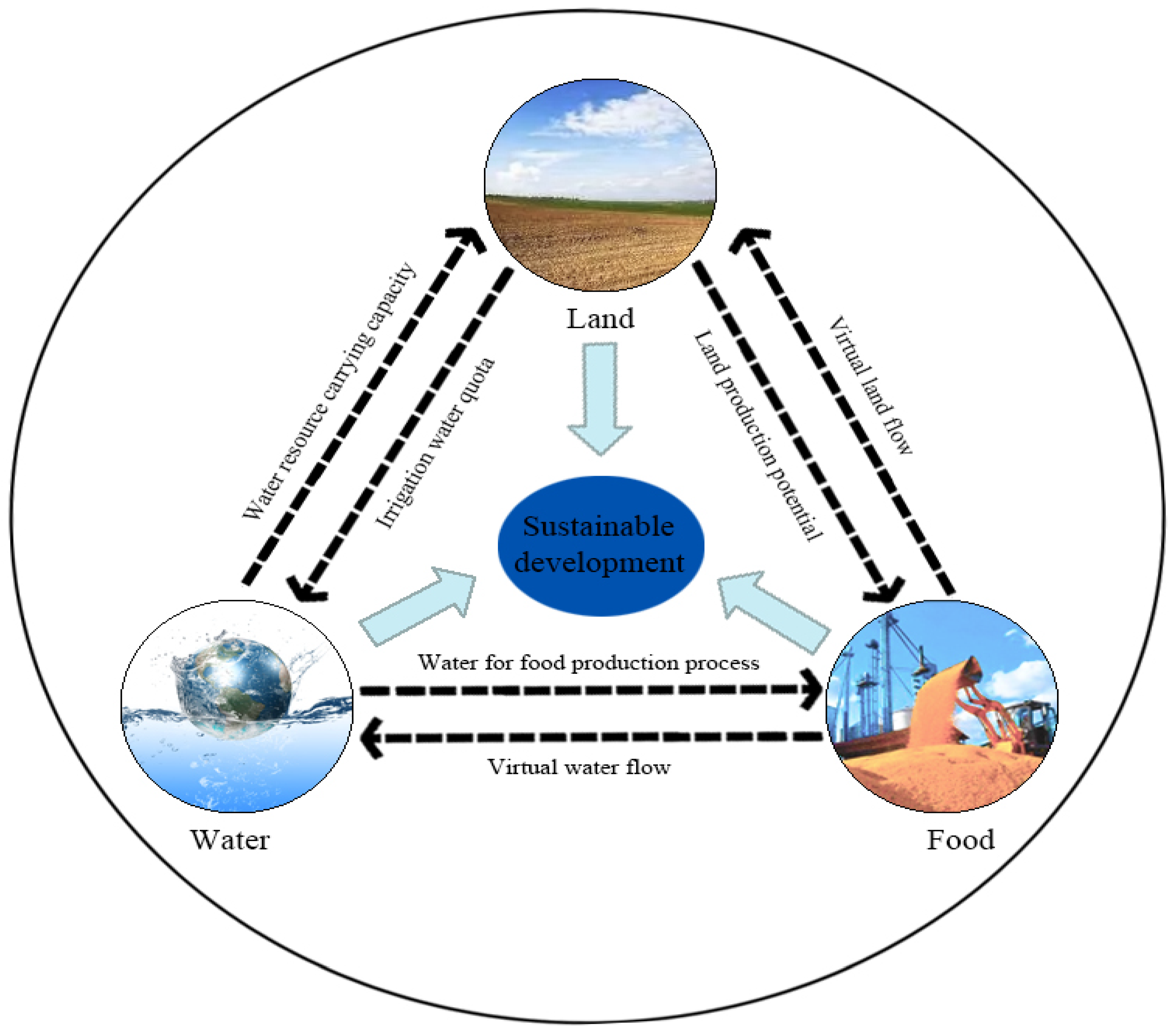
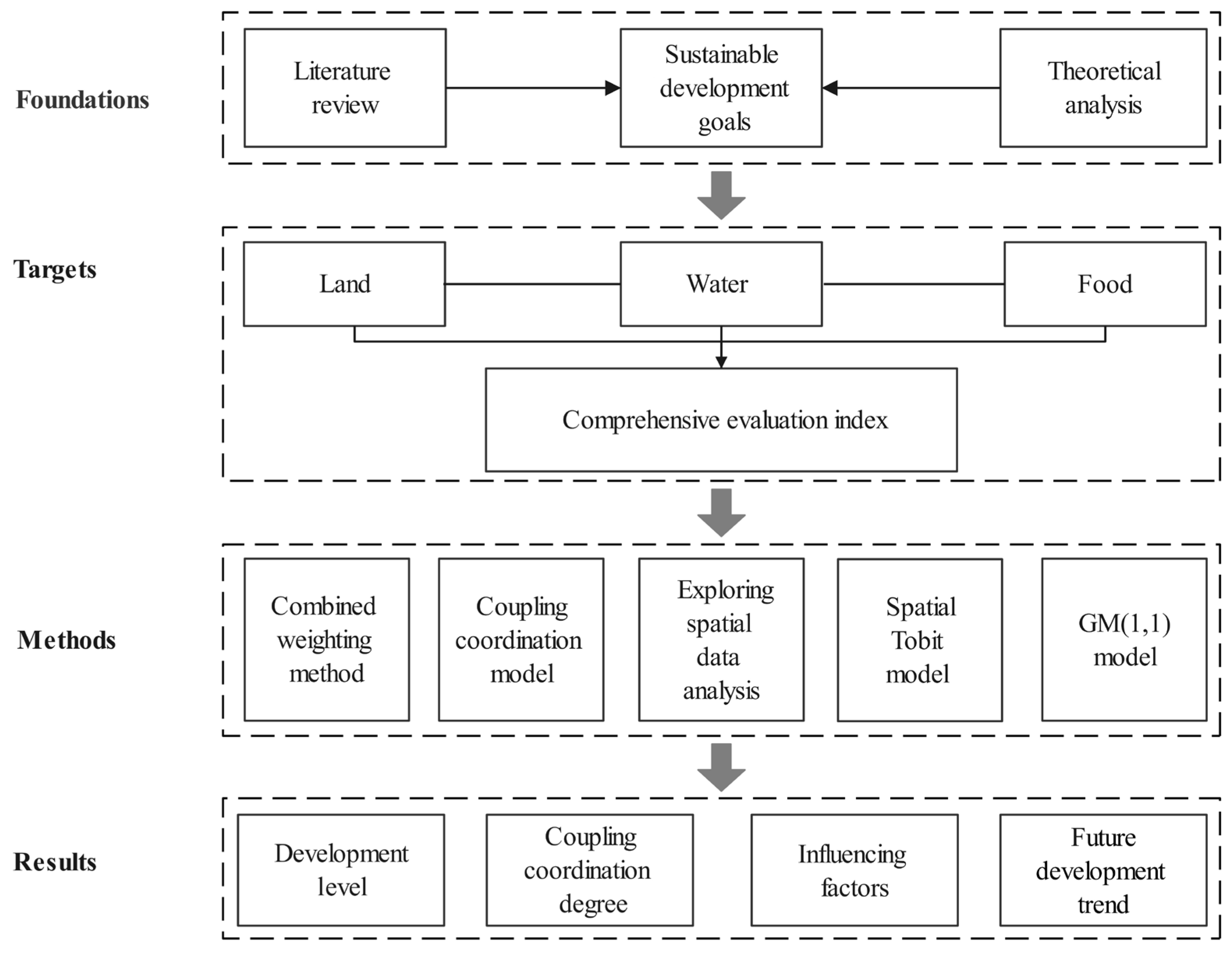
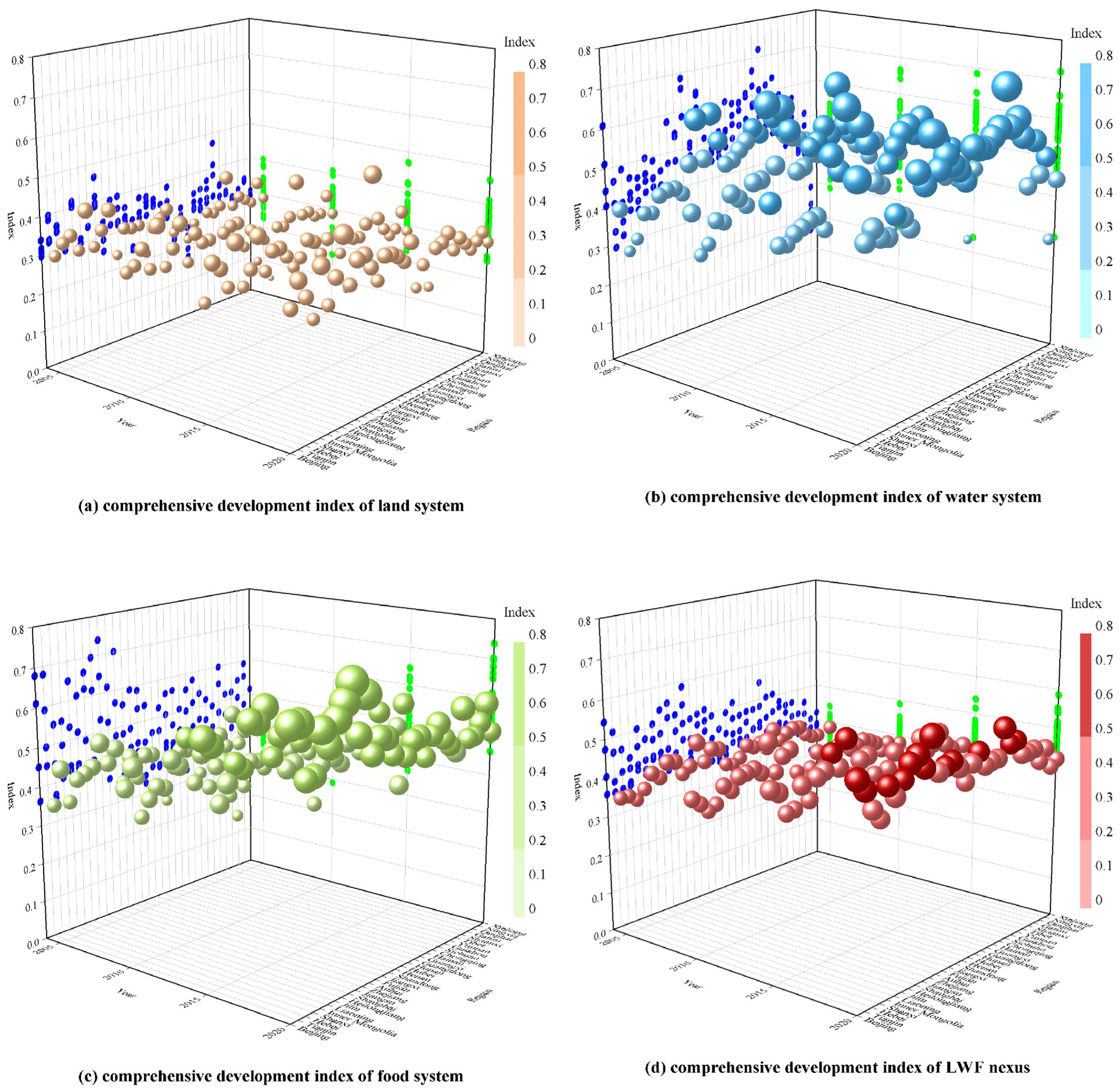

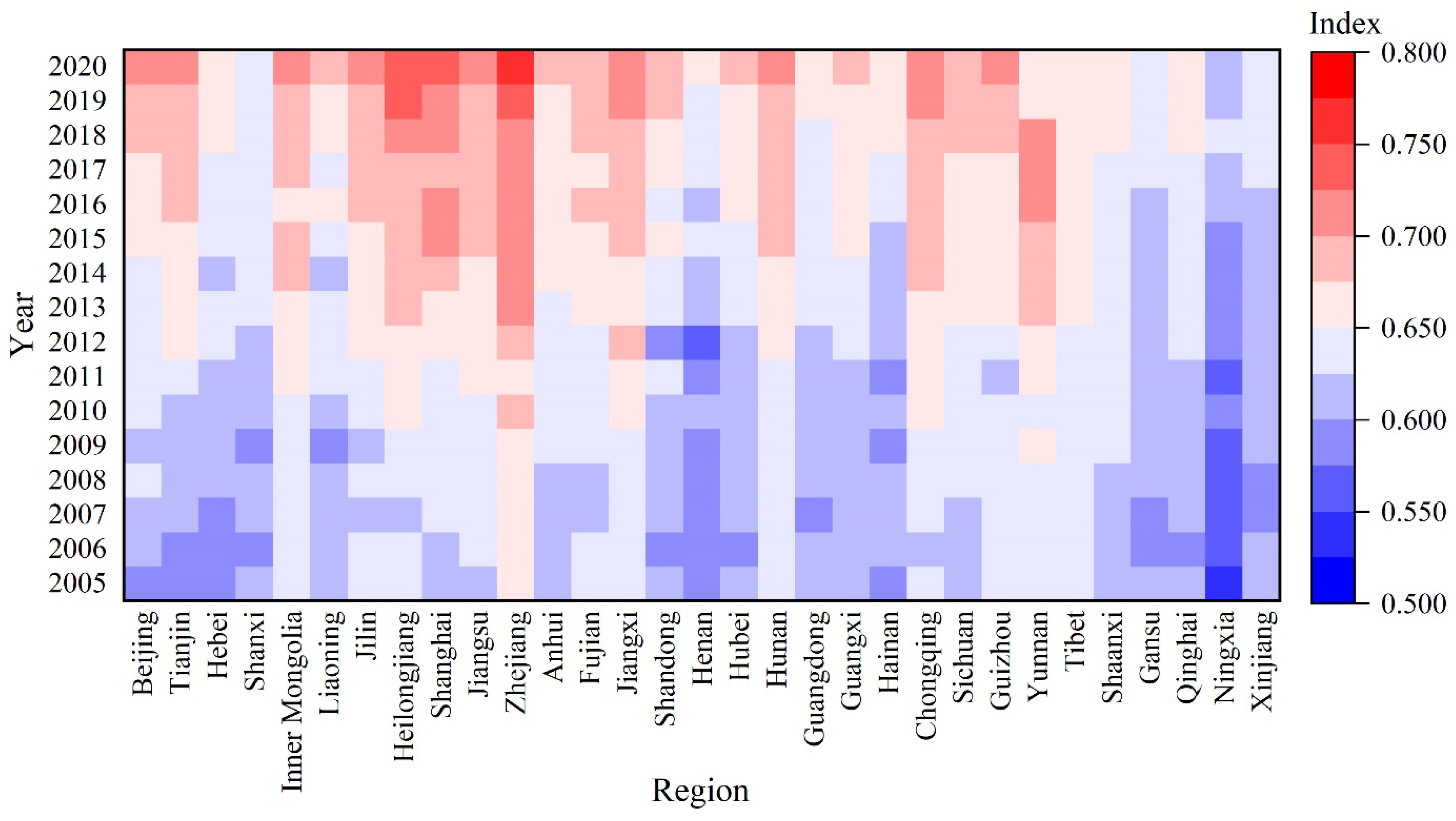
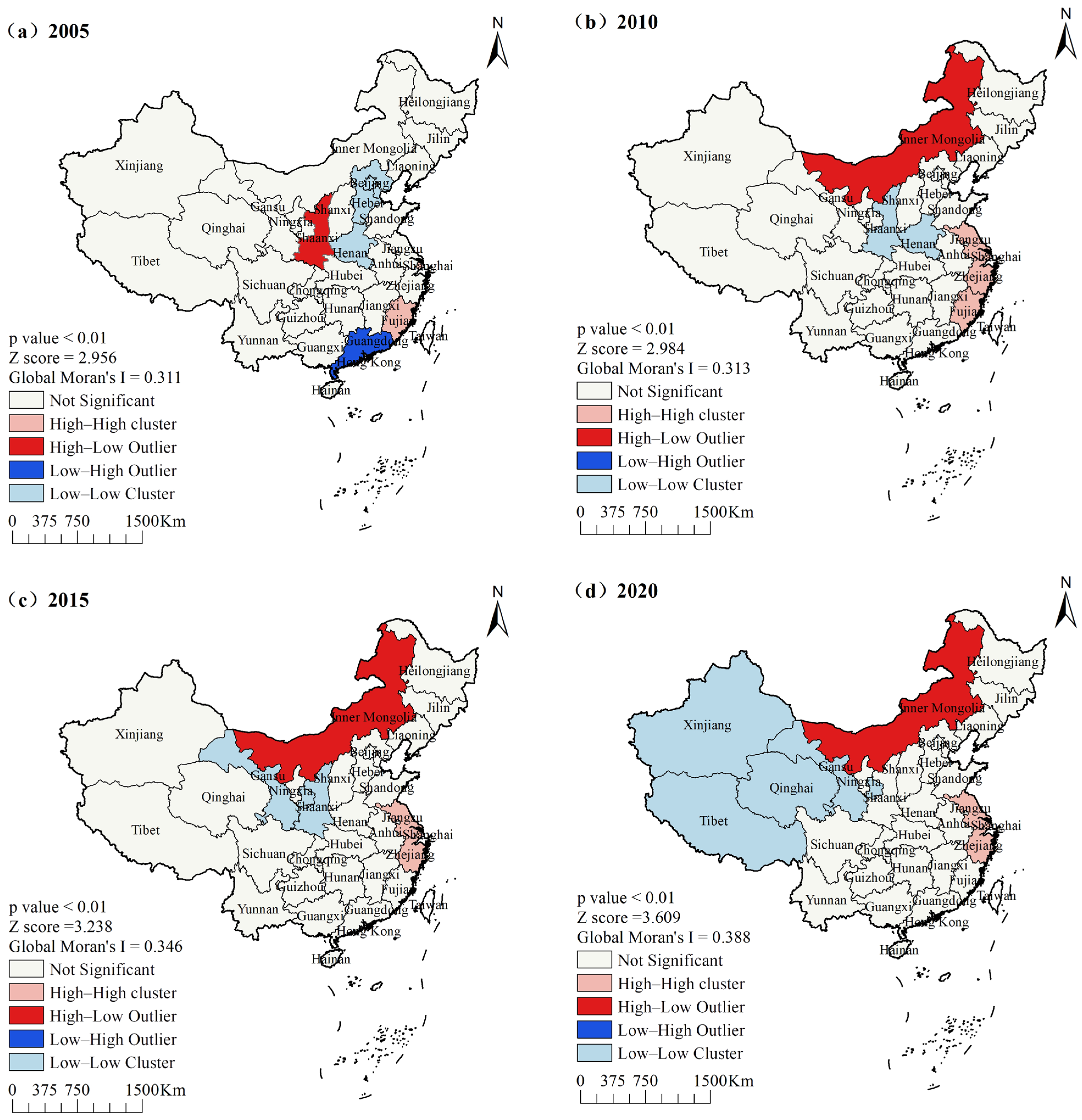
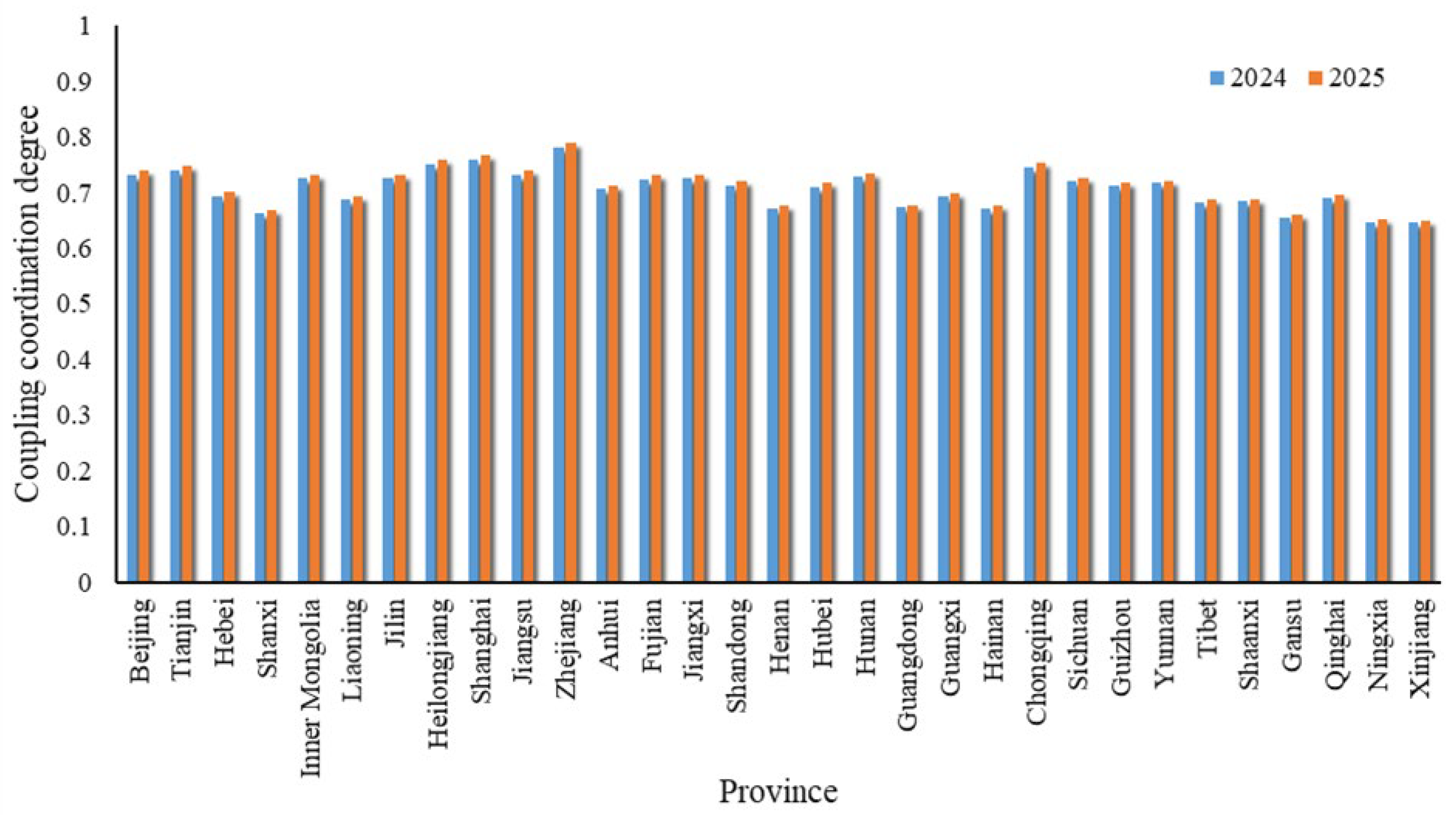
| System | Indicators | Data Source and Calculation | Unit | Attribute | No. | Combined Weight |
|---|---|---|---|---|---|---|
| Land | Average cultivated land output value | GDP of planting industry/cultivated area | yuan/hm2 | + | x1 | 0.177 |
| Total power of agricultural machinery per unit cultivated area | Total power of agricultural machinery/cultivated area | kw/hm2 | + | x2 | 0.111 | |
| Multiple cropping index | Total crop sown area/cultivated area | - | + | x3 | 0.081 | |
| Per capita cultivated area | Cultivated land area/total population | hm2/person | + | x4 | 0.191 | |
| Agricultural land conversion rate | Agricultural land area/total land area | % | + | x5 | 0.040 | |
| Soil erosion control rate | Soil erosion control area/soil erosion area | % | + | x6 | 0.208 | |
| Intensity of pesticide use on cultivated land | Pesticide application/cultivated area | t/hm2 | − | x7 | 0.116 | |
| Intensity of fertilizer use on cultivated land | Fertilizer application/cultivated area | t/hm2 | − | x8 | 0.076 | |
| Water | Irrigation water use coefficient | Water used by crops/water withdrawal from headwater | - | + | x9 | 0.054 |
| Agricultural water output value | GDP of primary production/agriculture water consumption | yuan/m3 | + | x10 | 0.140 | |
| Water use efficiency | Gross primary productivity/evaportranspiration | Kg/m3 | + | x11 | 0.064 | |
| Water-saving irrigation rate | Water saving irrigation area/effective irrigation area | % | + | x12 | 0.127 | |
| Water production modulus | Total water resources/area | m3/hm2 | + | x13 | 0.204 | |
| Agricultural irrigation water ratio | Agricultural irrigation water consumption/agricultural water consumption | % | − | x14 | 0.068 | |
| Groundwater extraction rate | Groundwater extraction/groundwater resources | % | − | x15 | 0.147 | |
| Water resource utilization ratio | Water resource utilization/total water resources | % | − | x16 | 0.195 | |
| Food | Per capita food production | Total food production/total population | kg/person | + | x17 | 0.219 |
| Food yield per hectare | Total food production/total food crop sown area | kg/hm2 | + | x18 | 0.069 | |
| Per capita disposable income of rural households | Statistical data | - | + | x19 | 0.281 | |
| Fluctuation coefficient of total food production | Fluctuation degree of total food production relative to long-term trends after excluding trend values | - | − | x20 | 0.143 | |
| Consumer Price Index of food for rural areas | Statistical data | - | − | x21 | 0.013 | |
| Food Resilience Index | Proportion of unaffected crop area to sown crop area | - | + | x22 | 0.032 | |
| Carbon emissions from food production | [35] | t | − | x23 | 0.121 | |
| Emission of non-point source pollution from food production | [36] | t | − | x24 | 0.122 |
| Coupling Coordination Stage | Coupling Coordination Degree | Coupling Coordination Type |
|---|---|---|
| Dysfunctional decline stage | [0–0.1] | Extreme disorder decline type |
| (0.1,0.2] | Severe disorder decline type | |
| (0.2,0.3] | Moderate disorder decline type | |
| (0.3,0.4] | Mild disorder decline type | |
| Transitional reconciliation stage | (0.4,0.5] | Nearly dysfunctional decline type |
| (0.5,0.6] | Barely coupled coordination type | |
| Coordinated development stage | (0.6,0.7] | Preliminary coupled coordination type |
| (0.7,0.8] | Intermediate coupled coordination type | |
| (0.8,0.9] | Good coupled coordination type | |
| (0.9,1.0] | High-quality coordination type |
| Variable | Description | Specific Meaning |
|---|---|---|
| URB | Urbanization | Proportion of urban population to total population |
| ECO | Economic Development | GDP per capita |
| ENV | Ecological Environment | Forest cover rate |
| SCI | Scientific and Technological Progress | Number of patent authorizations |
| IND | Industrial Structure | Degree of agricultural industry agglomeration |
| Year | Coupling Degree | Comprehensive Development Index | Coupling Coordinated Degree | Coupling Coordination Stage | Coupling Coordination Type |
|---|---|---|---|---|---|
| 2005 | 0.9780 | 0.3867 | 0.6146 | coordinated development stage | preliminary coupled coordination type |
| 2010 | 0.9747 | 0.4066 | 0.6290 | coordinated development stage | preliminary coupled coordination type |
| 2015 | 0.9723 | 0.4464 | 0.6582 | coordinated development stage | preliminary coupled coordination type |
| 2020 | 0.9696 | 0.4899 | 0.6886 | coordinated development stage | preliminary coupled coordination type |
| Variables | SDM | SAR | SEM |
|---|---|---|---|
| LnURB | −0.038 *** (−7.10) | −0.023 *** (−4.49) | −0.019 *** (−2.91) |
| LnECO | 0.015 *** (4.32) | 0.011 *** (4.73) | 0.013 *** (3.85) |
| LnENV | 0.016 *** (3.09) | 0.008 *** (2.88) | 0.015 *** 2.76 |
| LnSCI | 0.012 ** (2.11) | 0.012 ** (2.24) | 0.012 ** (2.09) |
| LnIND | 0.003 (1.21) | 0.004 (2.04) | 0.001 (0.70) |
| N | 496 | 496 | 496 |
| Adj. R2 | 0.240 | 0.207 | 0.138 |
| Log-likelihood | 1761.034 | 1803.923 | 1841.016 |
| LM Lag | 213.178 *** | ||
| LM Lag(Roubust) | 84.577 *** | ||
| LM Error | 142.508 *** | ||
| LM Error(Roubust) | 13.907 *** | ||
| Wald test | 31.85 *** | 32.44 *** | |
| LR test | 31.51 *** | 32.03 *** |
| Variables | Direct Effect | Indirect Effect | Total Effect |
|---|---|---|---|
| LnURB | −0.032 *** (−5.80) | −0.115 *** (−3.25) | −0.147 *** (−4.40) |
| LnECO | 0.015 *** (4.41) | −0.013 (−0.90) | 0.002 (0.11) |
| LnENV | 0.015 *** (2.96) | 0.038 (1.04) | 0.053 * (1.41) |
| LnSCI | 0.010 (1.18) | 0.024 *** (1.24) | 0.034 *** (3.60) |
| LnIND | 0.001 (0.8) | −0.006 (−0.4) | −0.005 (−0.4) |
Disclaimer/Publisher’s Note: The statements, opinions and data contained in all publications are solely those of the individual author(s) and contributor(s) and not of MDPI and/or the editor(s). MDPI and/or the editor(s) disclaim responsibility for any injury to people or property resulting from any ideas, methods, instructions or products referred to in the content. |
© 2025 by the authors. Licensee MDPI, Basel, Switzerland. This article is an open access article distributed under the terms and conditions of the Creative Commons Attribution (CC BY) license (https://creativecommons.org/licenses/by/4.0/).
Share and Cite
Liu, C.; Jiang, W.; Wei, J.; Lu, H.; Liu, Y.; Li, Q. A Coupling Coordination Assessment of the Land–Water–Food Nexus in China. Agriculture 2025, 15, 291. https://doi.org/10.3390/agriculture15030291
Liu C, Jiang W, Wei J, Lu H, Liu Y, Li Q. A Coupling Coordination Assessment of the Land–Water–Food Nexus in China. Agriculture. 2025; 15(3):291. https://doi.org/10.3390/agriculture15030291
Chicago/Turabian StyleLiu, Cong, Wenlai Jiang, Jianmei Wei, Hui Lu, Yang Liu, and Qing Li. 2025. "A Coupling Coordination Assessment of the Land–Water–Food Nexus in China" Agriculture 15, no. 3: 291. https://doi.org/10.3390/agriculture15030291
APA StyleLiu, C., Jiang, W., Wei, J., Lu, H., Liu, Y., & Li, Q. (2025). A Coupling Coordination Assessment of the Land–Water–Food Nexus in China. Agriculture, 15(3), 291. https://doi.org/10.3390/agriculture15030291





